Abandoned Transport Circus
Kyiv might be Europe’s single greatest city for late-twentieth century Modernist architecture. It boasts many wild, eclectic, and vividly imaginative examples of the style, built during the height of Soviet monument-mania. Though amongst its steel and concrete marvels of Soviet-era architecture, one of Kyiv’s most striking modern buildings has, in recent years, also become one of the city’s most problematic ruins. Autobus Park №7 – once the pride of the Ukrainian transport industry – exists today as a decaying morgue for almost a thousand abandoned buses.
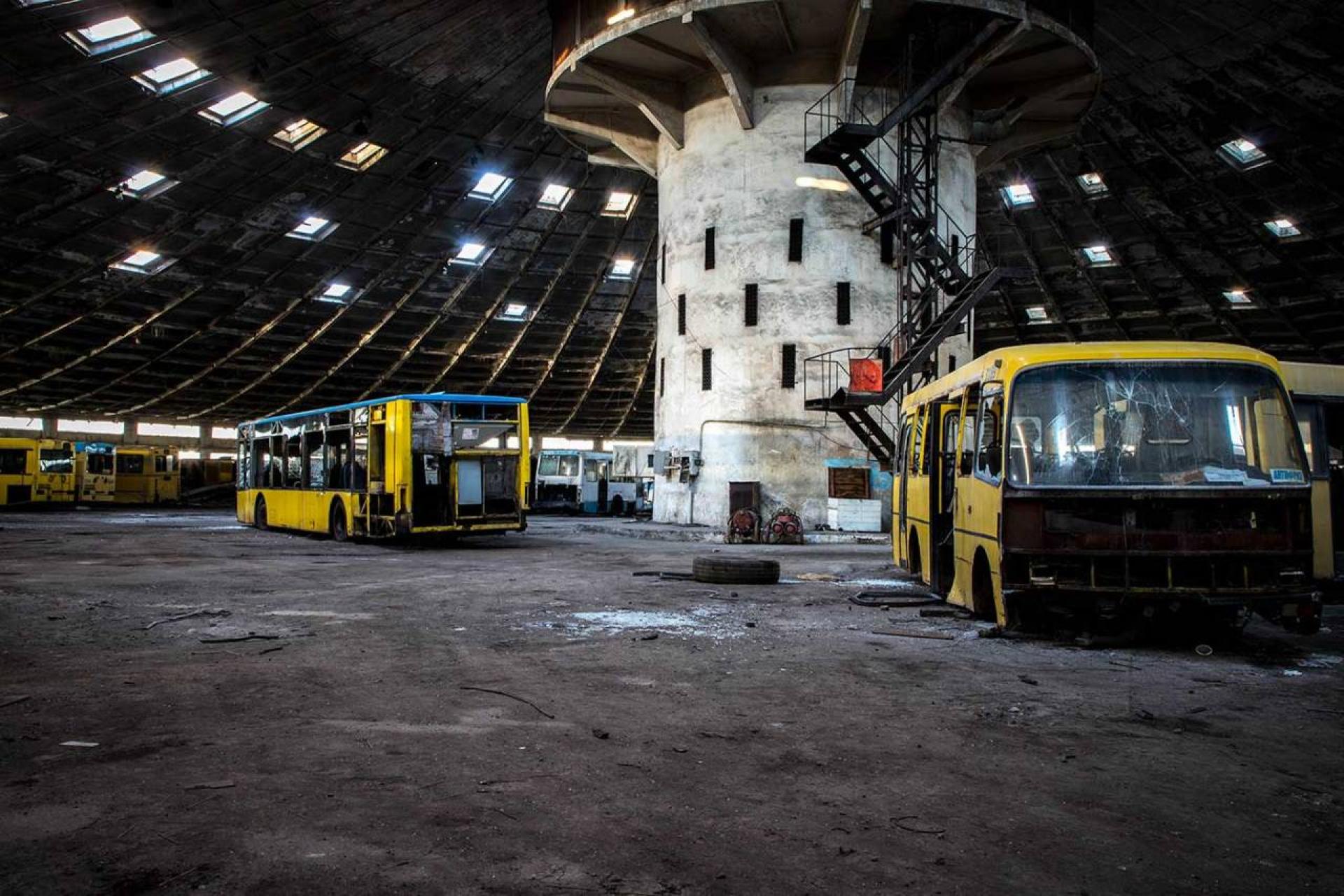
Autobus Park №7 today. | Photo © Darmon Richter
The design challenge of the Autobus Park №7 was to create an efficient depot capable of housing and maintaining a fleet of some 500 buses, in an urban environment where building space was limited. Had the building been constructed like a warehouse, or a factory, using a square plan and a regular pillar-based solution for supporting the roof, it was estimated that the total size of the building would have needed to be at least 4,000 square metres. However, an ingenious solution was proposed instead.
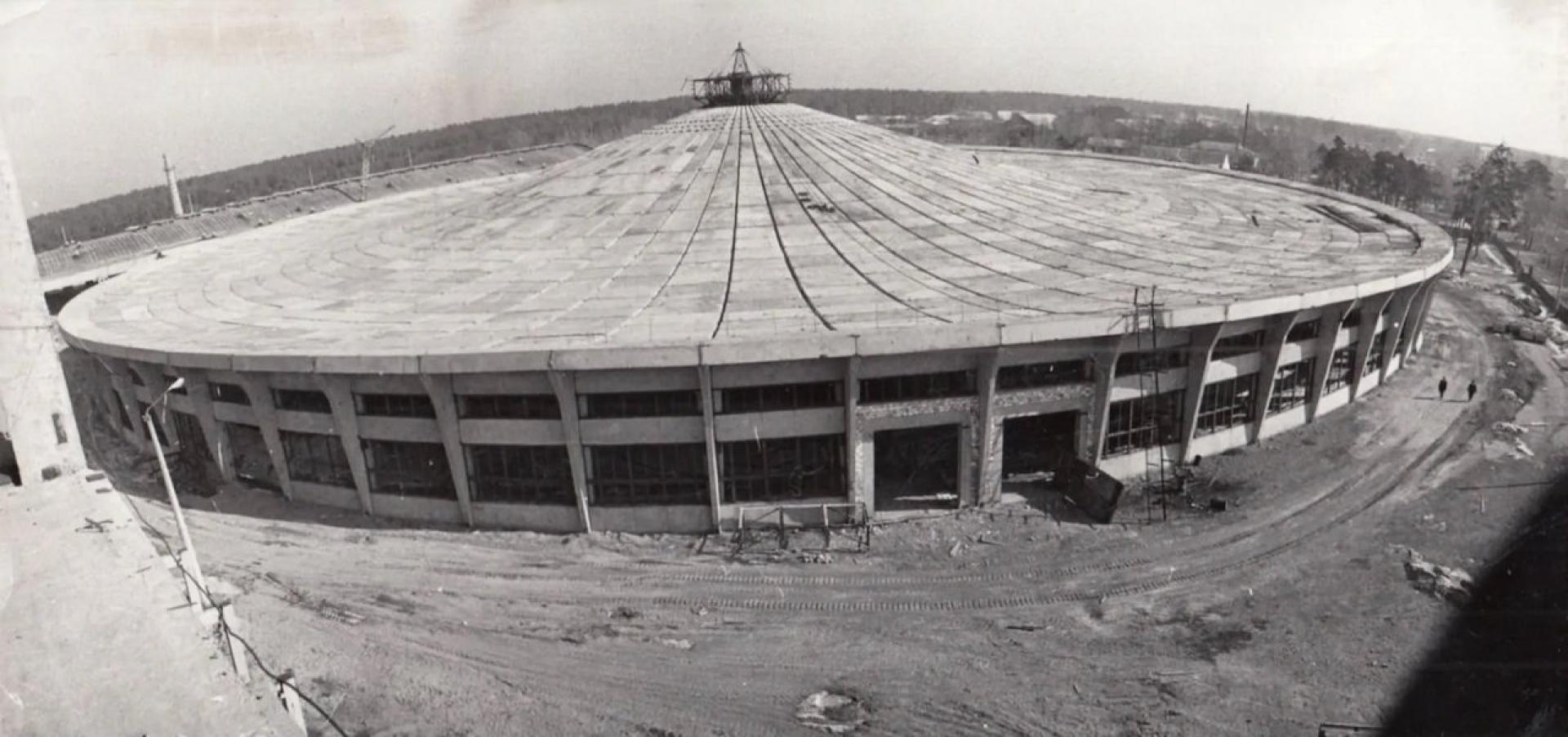
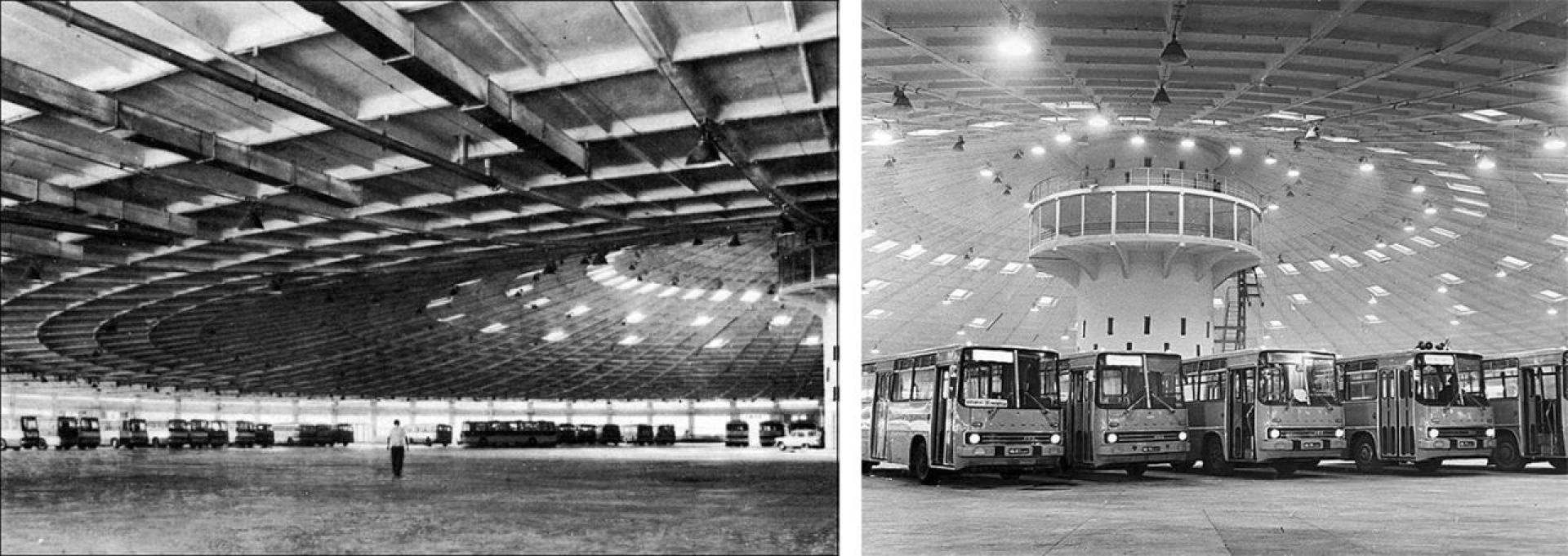
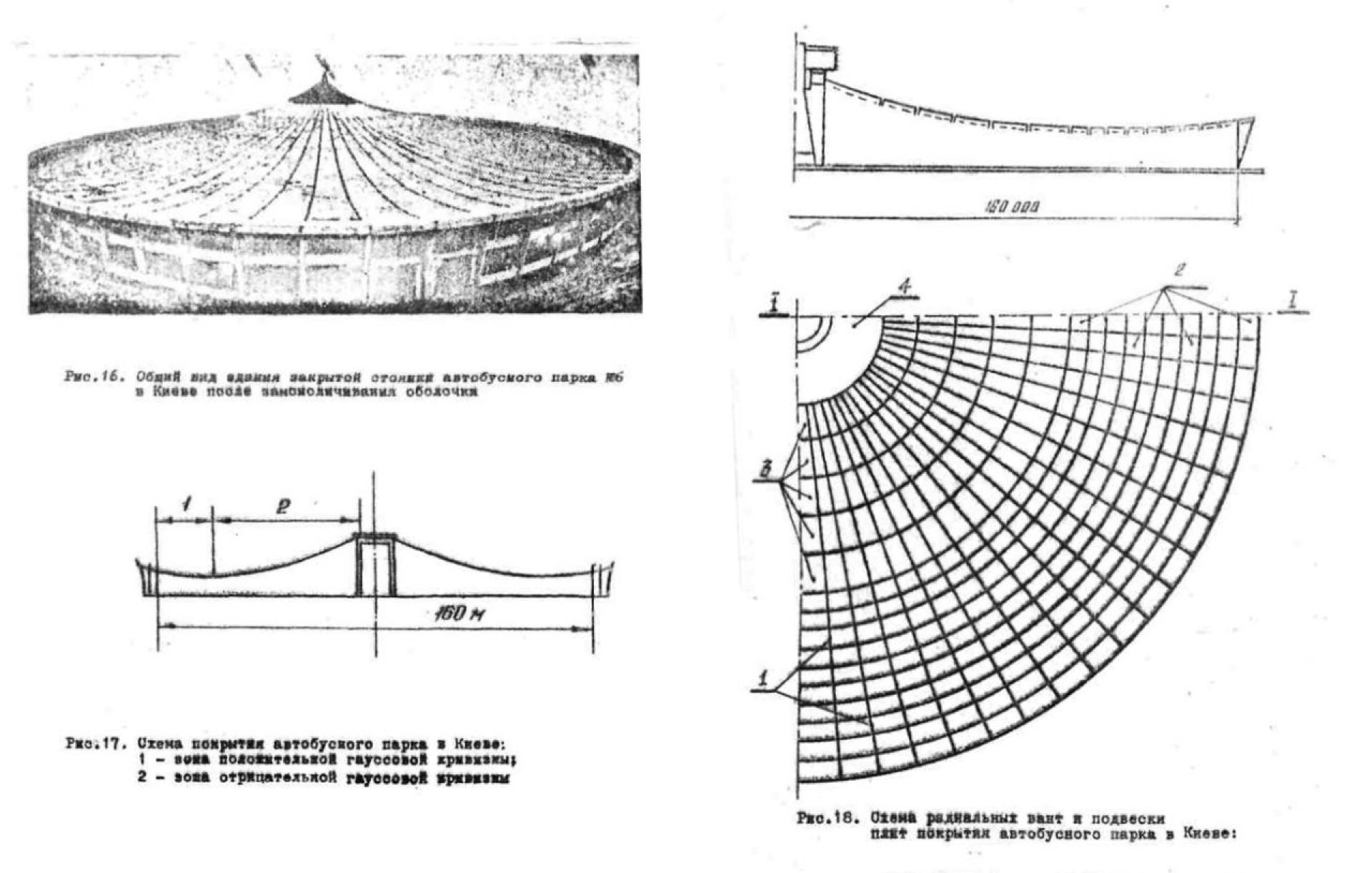
Under construction (1972), promotional photographs (1970s) and technical sketches (1979). | Photo via Khabarovsk Polytechnic Institute.
The chief engineers on the project, V. A. Kozlov and S. I. Smorgon, were responsible for the idea of using a cable-suspended roof. They took their inspiration from circus buildings – the cylindrical concrete-and-steel constructions which were by this time a ubiquitous feature in cities throughout the Soviet Union. By designing the building on a circular plan, and suspending concrete roof panels on cables strung between a central support pillar and the outer walls, it was found that both space and construction costs could be significantly reduced. Moreover, this design, with its organic, circular shape, lent itself more to what was then considered a modern and humanistic work environment for employees – while its form, reminiscent of circuses and Palaces of Culture, presented the bus depot not as a bland, functional box, but rather a community venue.
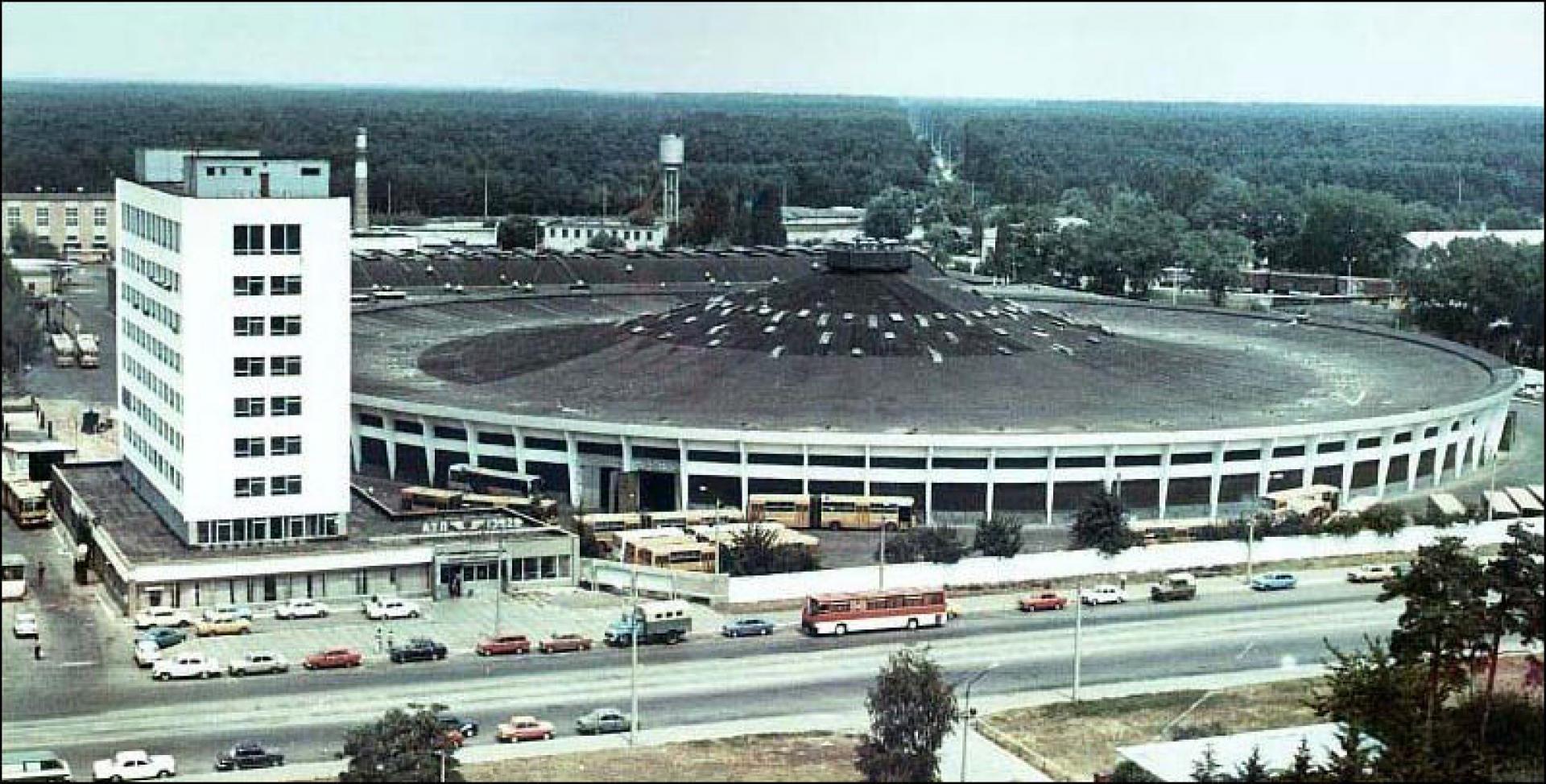
Kyiv’s Autobus Park №7 during its heyday with the tall building on the left accommodating administrative offices and staff canteens. | Photo via Exutopia
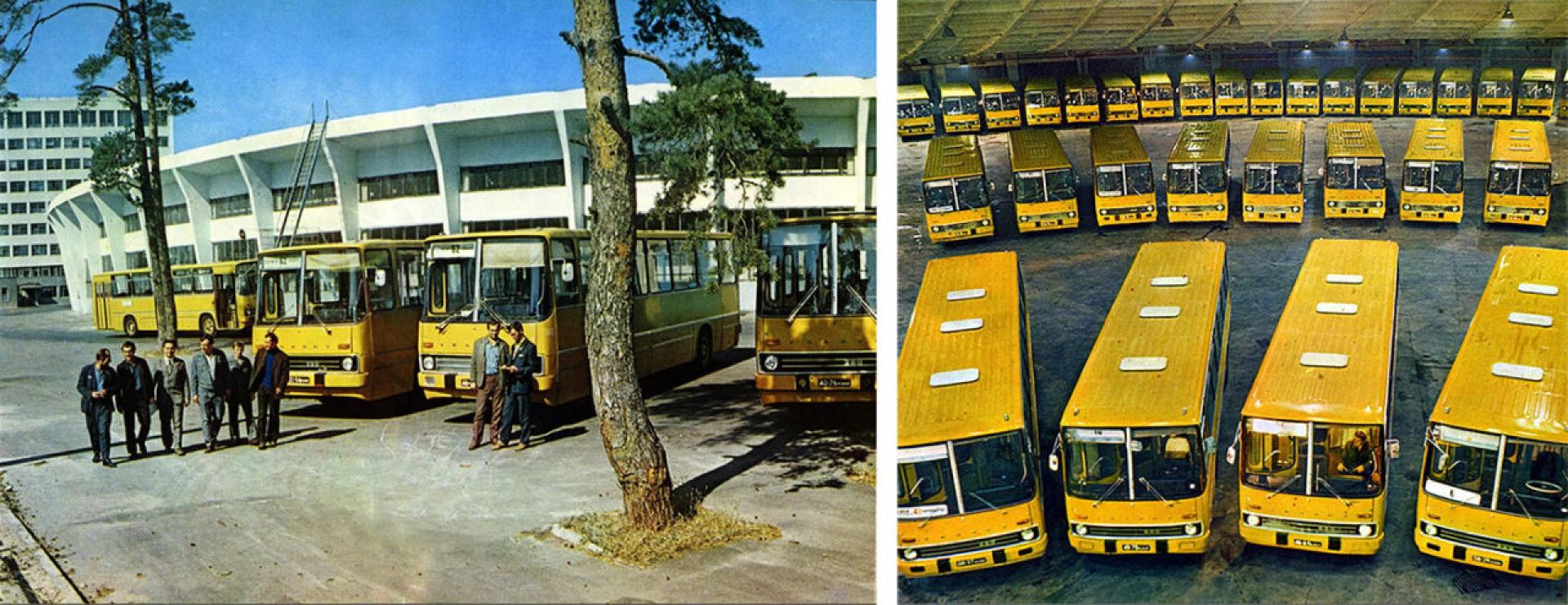
Left: Workers outside Kyiv Autobus Park №7 in 1977; right: A new fleet of buses ready for service, 1975. | Photo via Exutopia
Kozlov and Smorgon built a 1:10 scale model to test their idea. The central support pillar would be 18 metres high, a tower of reinforced concrete with a diameter of 8 metres, consisting of 0.3-metre thick concrete walls around an inner support of solid steel with a cross-section of 0.32 x 0.22 metres. Attached to the top of this pillar, were 84 radial cables – steel ropes with a diameter of 65 millimetres. Each of these cables was able to support a weight of up to 350 tons, and the roof would be constructed on top of them: a suspended tent dome, created from concrete plates, and with a total diameter of 160 metres.
On its completion in 1973, the building was considered an engineering marvel – its hanging roof was one of the largest ever constructed, and this system of support reduced the building’s necessary size from 40,000 square metres (the estimate for a pillar-supported roof) to a footprint of just 23,000 square metres.
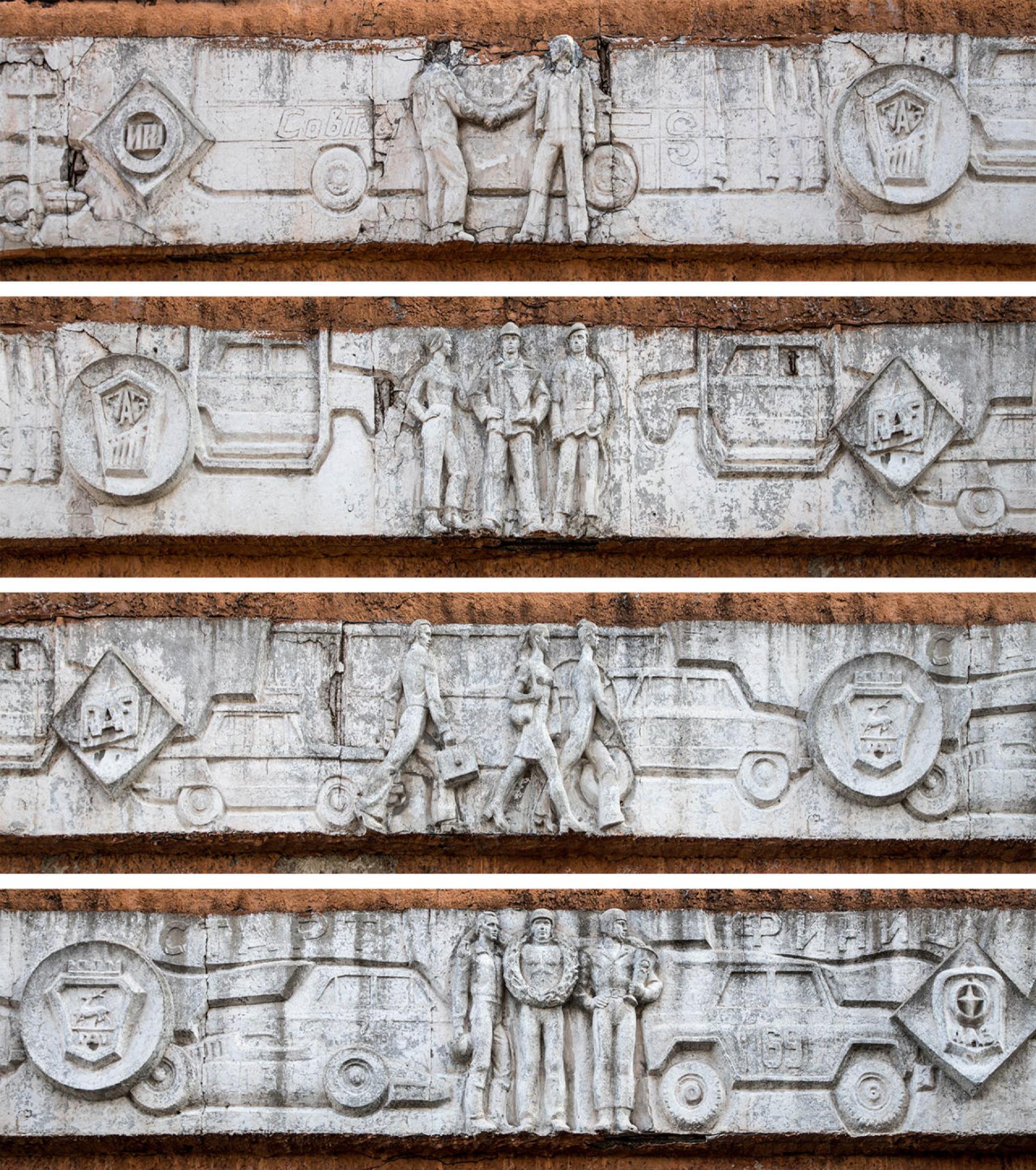
Details of the relief on the front of building showing staff, passengers, vehicles, and the logos of various automotive brands. | Photo © Darmon Richter
As much as possible, the design aimed to take advantage of natural light. The concrete plates of the roof were fitted with portholes, most of which were concentrated close around the main support tower. In the outer wall, upright glass cylinders were installed between concrete panels, serving as sturdy support pillars that both insulated the building against the cold outside, and allowed refracted light to shine into the wings of the building. This solution proved particularly robust, and most of these glass pillars have survived intact since the early 1970s until this day. Between them, these design choices resulted in an interior space and working area that enjoyed bright sunlight during the day, thus minimising the additional cost of electrical lighting.
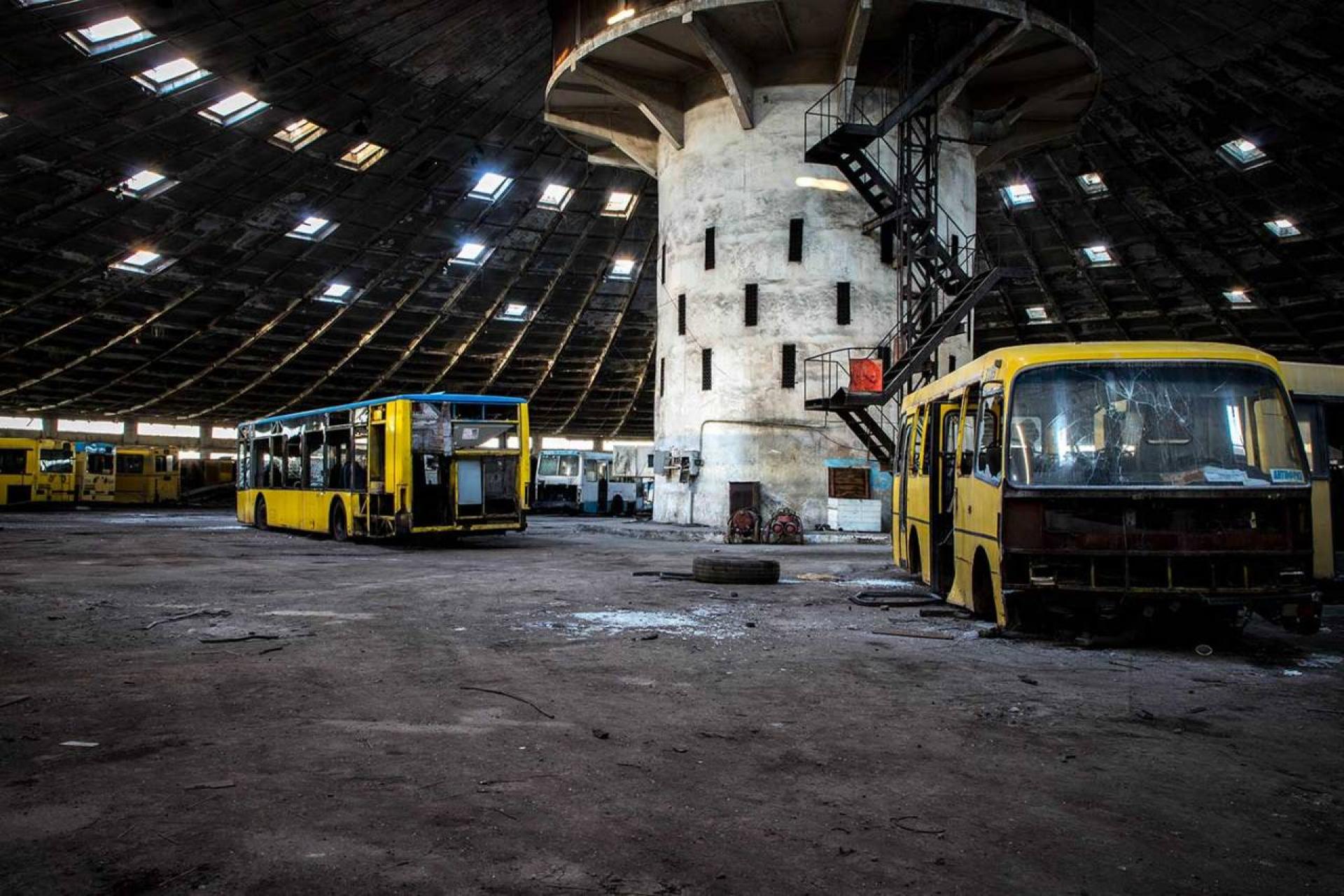
Attached to the 18m central support pillar, a metal staircase leads up to an observation platform. | Photo © Darmon Richter
Once operational, Autobus Park №7 was the largest vehicle depot in the Soviet Union – and it was rumoured, potentially the largest anywhere in the world. It served as more than just a garage, though. It was the base of operations for the entire fleet of buses serving the capital, including city buses, intercity buses, and also those working international routes, to Germany, Poland, Belarus and Russia. The building was fully air-conditioned, it featured a four-gate vehicle wash, and a mechanised repair bay fitted with conveyor belt systems. The building had a staff of 1,500 workers, and featured workers’ canteens, as well as a computing centre too – where teams calculated staff salaries and work shifts, as well as designing and optimising bus routes.
Sadly, the glory days of Autobus Park №7 would be short-lived. Following the break-up of the Soviet Union, many of the fleet’s international routes were discontinued. Services were gradually reduced through the 1990s, into the 2000s, while meanwhile, the building was increasingly used to store wrecked vehicles awaiting repair or decommissioning. The reduction of domestic bus routes in 2005 was a further blow, and eventually, in 2015, the autopark closed its doors for good – the building slipping into disrepair, as the once-proud circus was steadily transformed into a scrapyard.
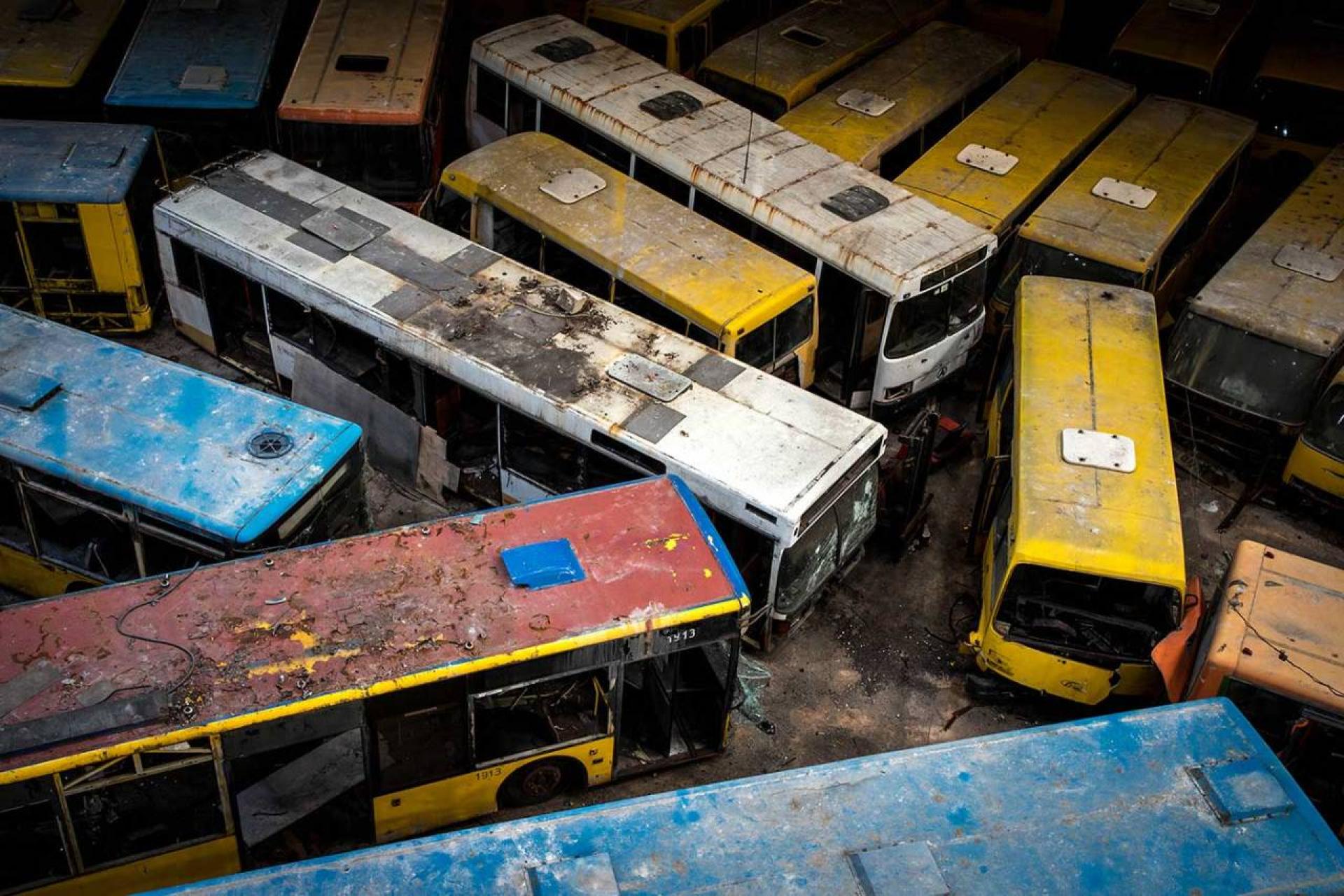
Since it was officially closed in 2015, almost 1,000 buses have been stored inside the abandoned building. | Photo © Darmon Richter
Today, Autobus Park №7 in Kyiv seems to be locked in a downward spiral of decay. The building itself is nothing short of an engineering marvel, an extraordinary work of architecture that supporters have suggested could be adapted now into a museum, or even a film studio. In April 2018 a petition was registered on the website of Kyiv City Council, calling for the building’s preservation – but it only received 321 votes, a long way short of its target of 10,000 signatures. Even had it been successful though, good intentions don’t count for much without action and intent on the part of Kyiv City Council; where currently, any talks of potential preservation are being blocked at a bureaucratic level.
For 25 years the building has been owned by the company Kyivpastrans (‘Kyiv Passenger Transportation), whose deputy general director, Sergey Litvinov, has said that Autobus Park №7 poses an imminent risk of collapse, and, given the cost and scale of such a project, would be almost impossible to save. Meanwhile, other former transport depots around the city have already been bulldozed to make room for new residential blocks and shopping centres. Many property developers would jump at the chance of getting their hands on this 23,000-square metre plot – and from the perspective of the current owners, it is probably a more attractive financial proposition. The building is neither listed nor protected, so were it empty, there would be nothing to stop the owners from knocking it down overnight.
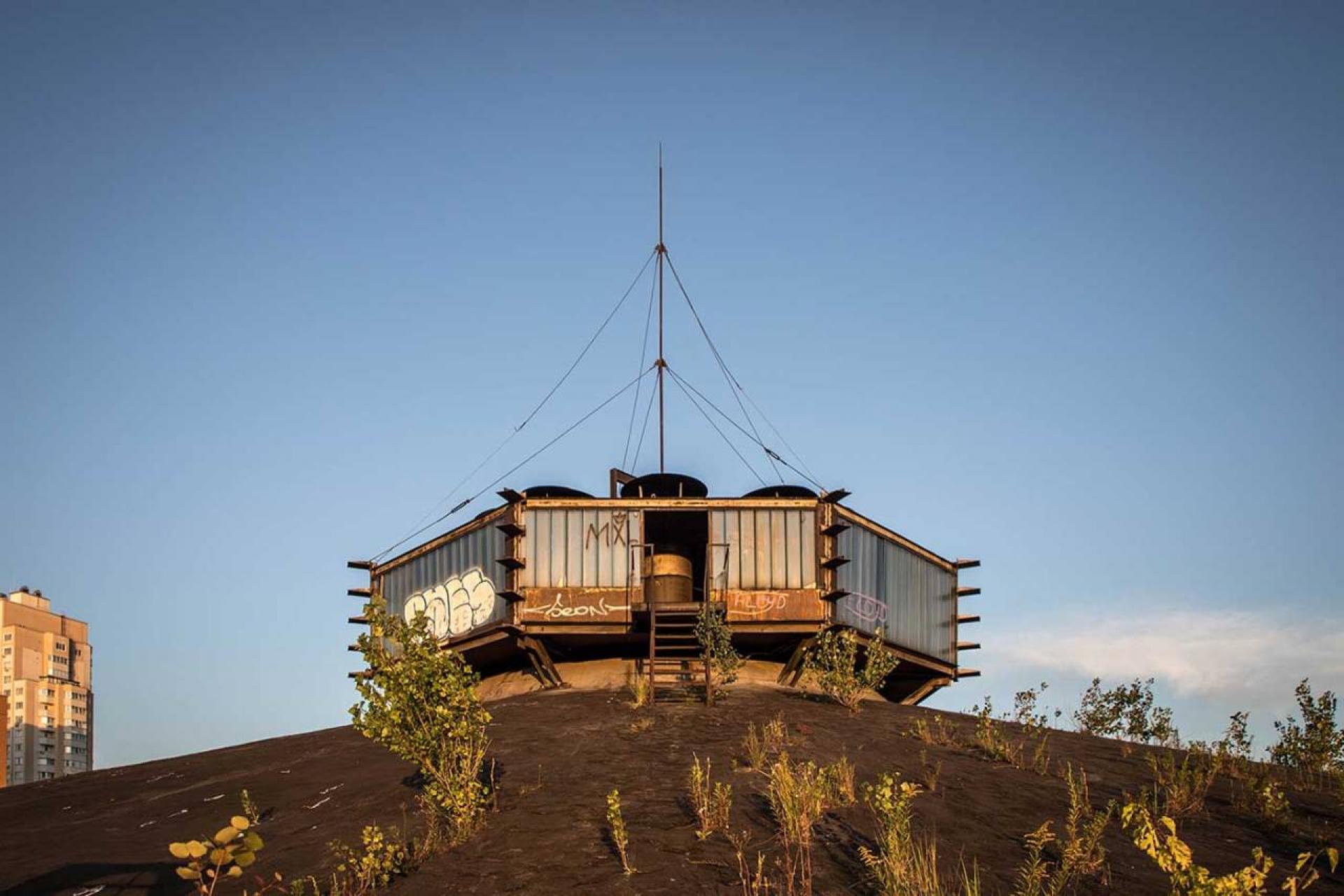
This rooftop capsule offered a panoramic view of the 180-metre diameter suspended roof of Autobus Park №7. | Photo © Darmon Richter
However, for the time being all parties are locked into a kind of stalemate over the building’s contents. The estimated 903 rusting vehicles stored inside (including LAZ, Volvo, Ikarus, and various other brands of urban and long-distance buses) pose a major administrative problem. These buses cannot easily be removed, or scrapped, as technically they are yet to be decommissioned from service. A new regulation that was introduced into Ukrainian law in 2013 complicated the bureaucratic procedure and created a backlog; so that all of the vehicles inside Autobus Park №7 today are – officially, on paper – still in service and awaiting audit. As such they cannot legally be taken apart for scrap, and right now, there’s nowhere else to store them in the city but here.
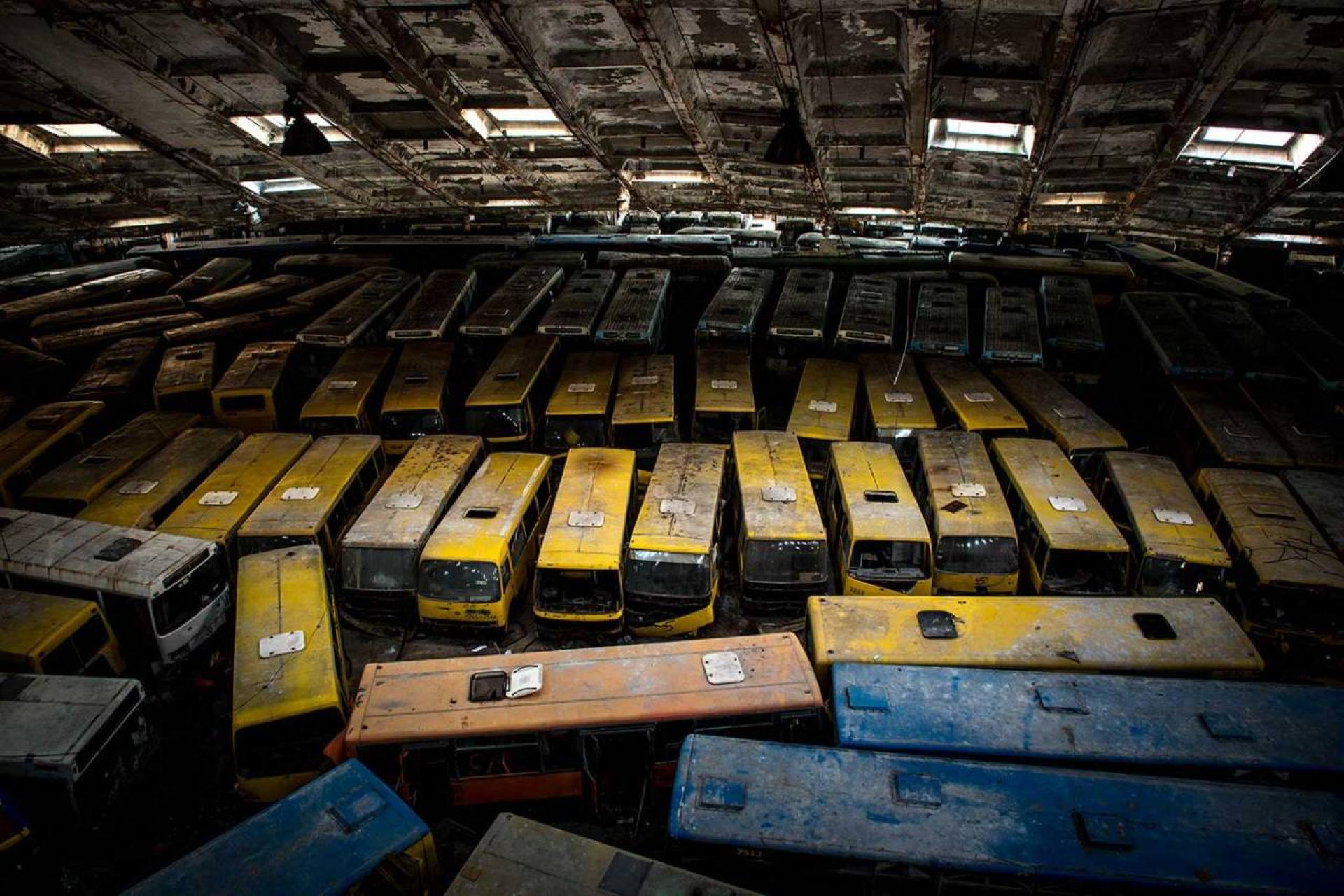
The vehicles have still not been officially decommissioned under Ukrainian law – which means they cannot be scrapped until the necessary paperwork is processed. | Photo © Darmon Richter
So for now, it’s a waiting game. If Kyivpastrans and Kyiv City Council are able to solve the bureaucratic headache of their vehicle decommissioning procedure, remove the abandoned buses, and then find the will, not to mention the funding, to undertake the colossal project of preserving Autobus Park №7 (while turning down more lucrative offers from property developers in the process), then perhaps the building might yet be saved. But in the meanwhile, the circus roof is sagging, and young trees are already sprouting from cracks in the concrete.
It may just be that this building, an engineering marvel of the Soviet period, having failed to find its place in a post-Soviet world, is doomed to go the same way as the regime that built it.
by Darmon Richter
[adapted with permission from an article at Ex Utopia]
Sources:
- Smena Magazine (1974) Issue No.19
- Khabarovsk Polytechnic Institute (1979) Reinforced Concrete Space Structures (lecture notes, p.24-26), M. P. Danilovsky
- Hmarochos (2018) Why are Storage Facilities for Faulty Kyivpastrans Buses Being Set Up in Kyiv?
- Kiev Vlast (2019) Kyiv City Council Decided to Solve the Riddle of Bus Depot №7